We already covered Sony's Xperia Tablet Zannouncement earlier this week, and Sony was showing off its smartphone counterpart at CES last month. But since we're actually on the floor here at Mobile World Congress, we thought we'd take some time to get our hands on the device (and its smartphone counterpart). Maybe, just maybe, we'd even ask to test out the waterproofing—Ars does have a long and illustrious history of "stress testing" consumer electronics after all. Luckily for us, Sony was prepared.
An immersive experience
To recap, both the Xperia Z smartphone and Xperia Tablet Z can be immersed in up to three feet of water for about thirty minutes without suffering any ill effects. Sony was clear that this feature doesn't make the devices suitable for use in the swimming pool, but dropping them in the tub (or in some other more embarrassing water-filled bathroom fixture) for an instant or spilling your coffee all over them isn't going to ruin them.
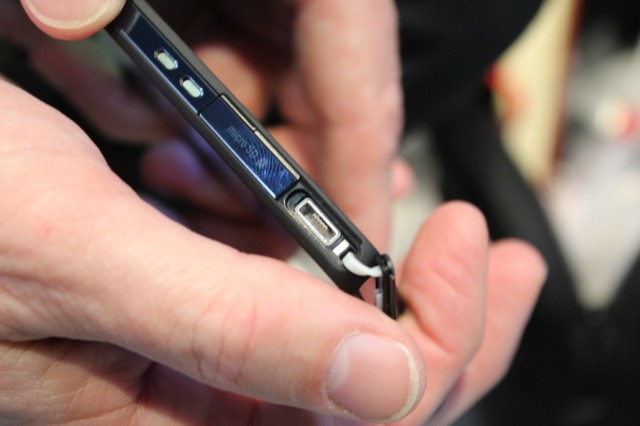
Both phone and tablet use small rubber covers to protect the phone's ports from liquid intrusion.
The various ports—microSD, micro-USB, and the headphone jack among them—are all protected by small covers that keep water and dust out. If one of these covers is open or breaks, your device will be just as susceptible to water damage as any other phone or tablet.
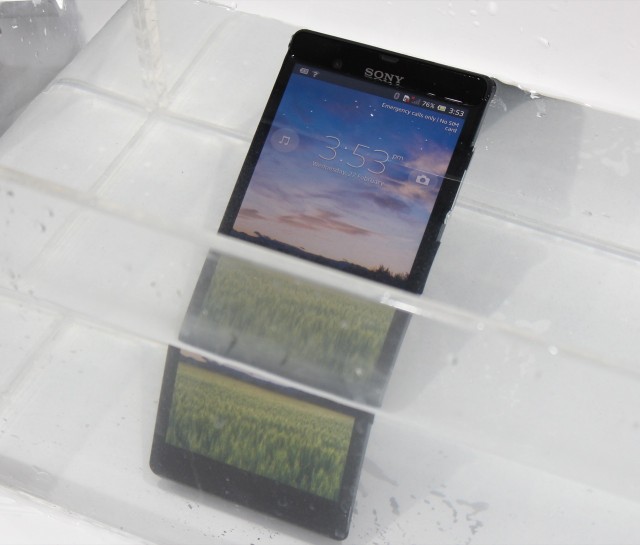
The Xperia Z takes a bath—you can still press the power button and interact with the screen when it's underwater.
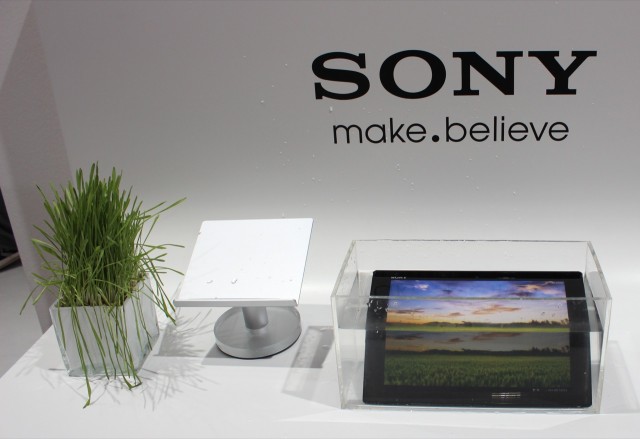
We threw the Tablet Z in next, with the same results—the device was toweled off and kept right on working afterward.
Both devices could obviously be turned on and used underwater if necessary, something our Sony rep pointed out made them well-suited for use in the kitchen. Toweling them off is all you'll need to do in case of contact with liquid (even if our impulse is still to be terrified of getting our smartphones wet).
More conventional hands-on impressions
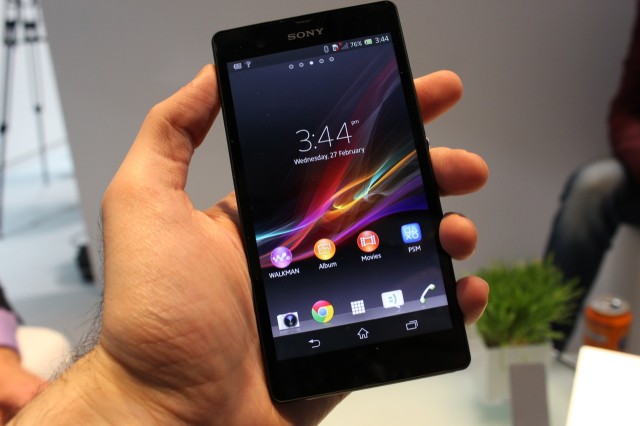
The Xperia Z also works if it's not immersed in liquid.
The waterproofing is great, but luckily the phone and tablet also work on dry land. We certainly weren't floored by the last Sony flagship phone we reviewed, but both the phone and the tablet seem well put-together. They also share a common hardware and software design language that makes them look nice together.
Both devices favor flat surfaces and edges to the slightly curved ones favored by most other smartphones. Both feel very light in the hand—the phone is 0.31" thick and weighs in at 5.15 ounces, while the tablet is just 0.27" thick and a very light 1.05 pounds (down from 1.33 pounds for the Nexus 10 and 1.44 pounds for the latest iPad). One of my longstanding issues with widescreen tablets has been that their weight and balance make them difficult to hold with one hand for a sustained period of time, but the Xperia Tablet Z is actually quite comfortable when held this way. We hope the lightness doesn't come at the cost of battery life, but barring that, we were impressed by how it felt to hold and use.
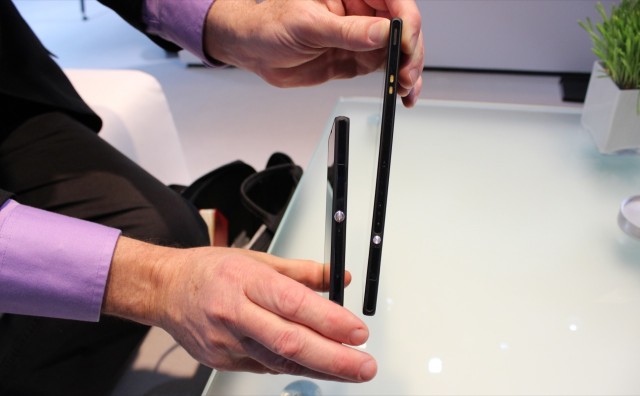
Both tablet and phone are thin and light, and they share common design touches (see the power button in this photo, for example).
Both run Android 4.1.2 with a custom Sony skin, and the devices also share many of the same internals—a quad-core Snapdragon S4 Pro SoC running at 1.5GHz, 2GB or RAM, and expandable internal storage courtesy of a microSD card slot (both devices sport 16GB of built-in storage, though a 32GB version of the Tablet Z will also be available). They support the common array of connectivity interfaces—dual-band Wi-Fi, Bluetooth 4.0, NFC, and (in the smartphone) 3G and LTE support. The tablet lacks cellular connectivity, but as we mentioned in our original write-up it does have the IR blaster for use with televisions.
The Xperia Z smartphone has a 5-inch 1080p display that we've seen in quite a few next-generation Android phones and a 13 megapixel camera, while the Tablet Z uses a 10.1-inch 1920×1200 display and a slightly lower-specced 8 megapixel camera. (This reflects the reality that people are much more likely to count on their smartphones as cameras.) The screen isn't as dense as the one on the Retina iPads or the Nexus 4, but it's still a reasonably nice 224ppi.
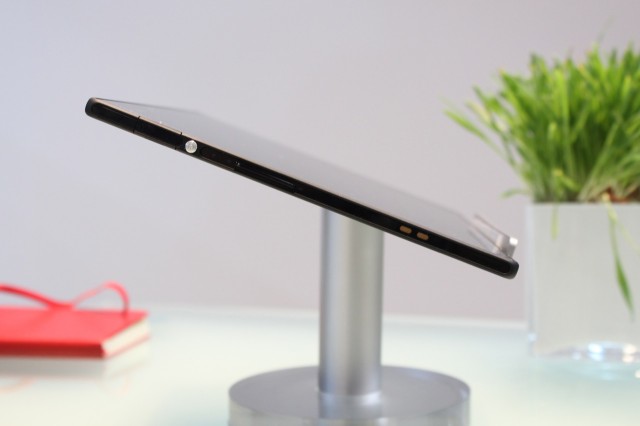
The Xperia Tablet Z is quite thin and light.
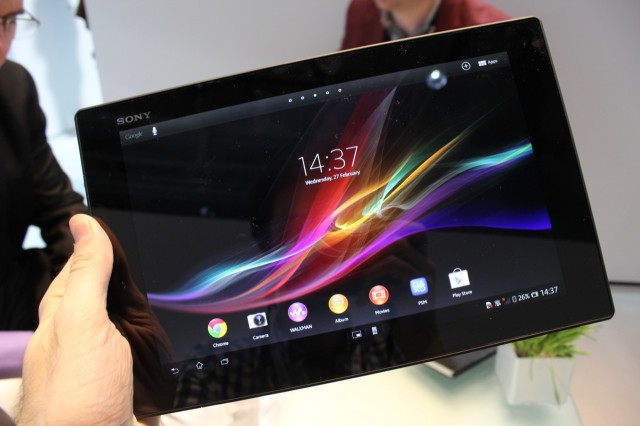
This makes one-handed operation more plausible than in any other widescreen 10-inch tablet I've tried.
If the tablet has one weakness that's immediately apparent, it's the price—it starts at $499 for the 16GB version and $599 for the 32GB version. This pricing is commensurate with that of the iPad, but Android tablets have historically had issues doing well when priced in the same range as Apple's juggernaut. We don't have US pricing information for the phone, but we expect it to be in the same range as other high-end Android handsets—something like $199 with a two-year contract.
The tablet will be released in the US at some point this spring, and it will be available globally on March 1 (the Xperia Z is already on sale in Japan, but we have no specific information about a US release date). We've requested review units of both so we can give them a proper going-over (and so we can spend more time immersing them in liquid).
No comments:
Post a Comment
Let us know your Thoughts and ideas!
Your comment will be deleted if you
Spam , Adv. Or use of bad language!
Try not to! And thank for visiting and for the comment
Keep visiting and spread and share our post !!
Sharing is a kind way of caring!! Thanks again!